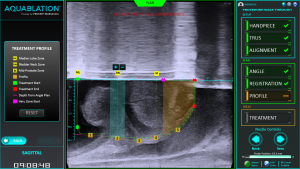Aquablation Therapy Surgical Treatment for BPH
Aquablation therapy is a new type of surgical treatment for benign prostatic hyperplasia (BPH). Aquablation therapy uses the power of water delivered with robotic precision to provide long-lasting BPH relief.
How Aquablation Therapy Works
Aquablation therapy is a resective procedure, which means that the prostate tissue causing symptoms is surgically removed. No incision is made in the abdomen, as the prostate is reached through the urethra. Aquablation therapy is performed in a hospital and is done under anesthesia. The procedure typically takes less than an hour and involves an overnight stay.
There Are Two Key Steps To The Aquablation Procedure:
Step 1. Creating a Surgical Map
Every prostate is unique in size and shape. Aquablation therapy enables the surgeon to customize the procedure to your specific anatomy. Aquablation combines a camera (cystoscope) with ultrasound imaging to visualize the entire prostate in real-time. Ultrasound imaging allows the surgeon to map out the portion of the prostate tissue to be removed. This mapping enables the surgeon to avoid removing the parts of the prostate that cause complications like erectile dysfunction, ejaculatory dysfunction, and incontinence.
Step 2. Removing the Prostate Tissue
Once your surgeon has created a surgical map, a robotically-controlled, heat-free waterjet removes the prostate tissue that was outlined on the map. This robotic technology minimizes human error in removing prostate tissue and ensures the prostate tissue is removed precisely. When required, your surgeon may choose to use a minimal amount of cautery following an Aquablation procedure to control bleeding.
Removing the Prostate Tissue:
Please accept cookies to access this content
What are the Side Effects of Aquablation Therapy?
Men typically delay surgery because they are concerned about side effects, specifically sexual side effects such as erectile dysfunction. In clinical studies, men who had Aquablation therapy had a very low rate of irreversible complications—incontinence, ejaculatory dysfunction, erectile dysfunction.[2,3]
Benefits of Aquablation
- Very low rate of complications and sexual side effects such as erectile dysfunction, ejaculatory dysfunction, and urinary incontinence.
- The use of a camera (cystoscope) and ultrasound imaging provides a real-time view of the entire prostate, enabling your surgeon to accurately map out only the section of the prostate to be removed.
- Aquablation is the only heat-free BPH procedure to remove prostate tissue, contributing to the treatment’s extremely low rate of sexual and urinary complications.
- Robotic technology ensures that prostate tissue is removed precisely.
- Clinical studies have shown that Aquablation Therapy provides long-term relief of BPH symptoms.
Aquablation Recovery
- Use of a catheter, in some cases.
- Typically, patients stay overnight in the hospital.
- Mild burning during urination for a couple of weeks.
References:
1. Data from a global survey of 300 patients with BPH. Data on file at PROCEPT BioRobotics.2. Gilling, P, et al. Three-Year Outcomes after Aquablation Therapy Compared to TURP: Results from a Blinded Randomized Trial. Can J Urol. 2020 Feb;27(1):10072-10079.
3. Bhojani, N, etal. Aquablation for Benign Prostatic Hyperplasia in Large Prostates (80-150 cc): 1-Year Results. Urology. 2019 Jul;129:1-7.4.Data on file at PROCEPT BioRobotics.
